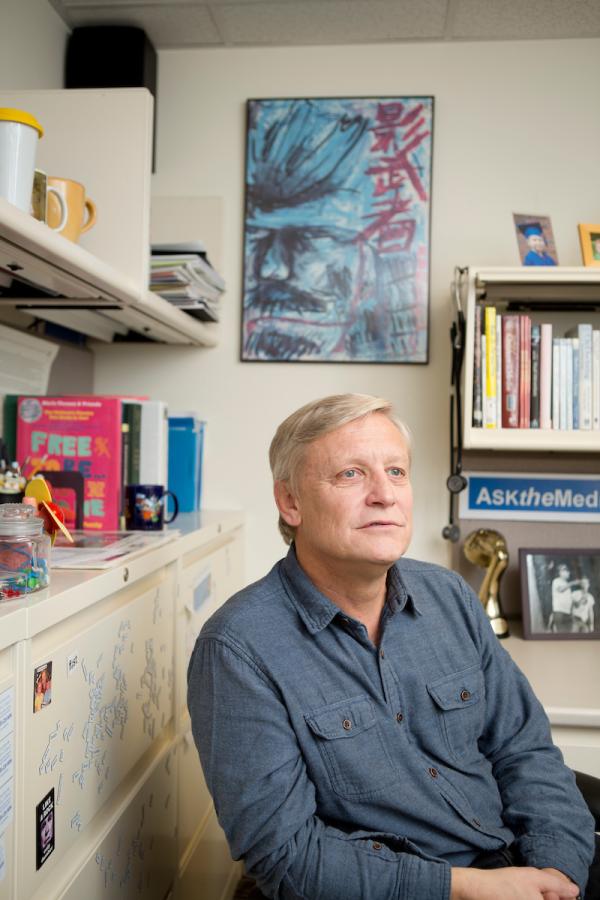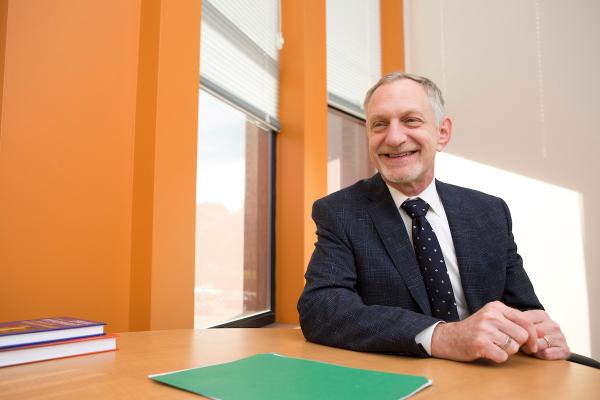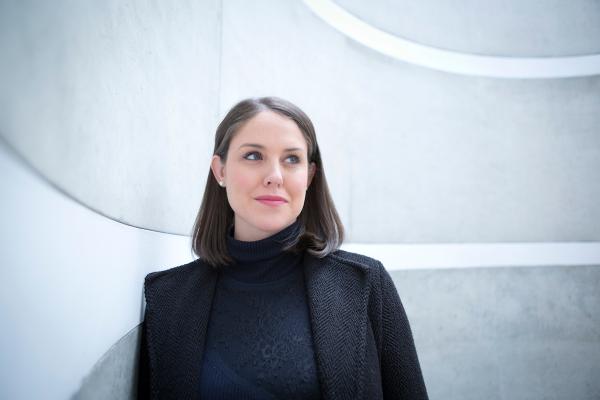Trust Me, I'm Your Smartphone
Does digital communication affect our sense of belonging?
- Feature

Place the winky face emoticon where you think it best fits: Social media makes you feel lonely. Social media makes you feel less alone. Smartphone use damages relationships and facilitates ideological echo chambers. Smartphone use strengthens bonds with others and exposes us to more diverse opinions.
According to the Pew Research Center, three-quarters of U.S. adults own smartphones and three-quarters of teens own or have access to one. Ninety-two percent of teens go online daily, 24 percent of them “almost constantly.” Ninety percent of teens and 65 percent of adults use social media.
As online life grows and headlines speculate about whether social media will be the downfall or the savior of human civilization, researchers struggle to understand how digitally mediating our interactions deepens or damages our sense of belonging, which in turn could influence the health of individuals, relationships, and communities.

“Digital media is arguably the most universal environmental health issue in the twenty-first century—as important as immunizations, bicycle helmets, and safety belts,” says Michael Rich ’91, an HMS associate professor of pediatrics at Boston Children’s Hospital and an associate professor at the Harvard T.H. Chan School of Public Health.
Pinpointing the effects of digital communication on social structure and function, however, is proving extremely difficult. Investigations by researchers throughout Harvard University into the effects of social media on human happiness and healthy aging, child and adolescent development, interpersonal communication, and engagement in civic society are finding cause for both optimism and concern.
What’s on Your Mind?
Because it’s increasingly clear that every person who uses the internet uses it differently, researchers are working to discern who might be helped and who might be harmed by socializing online. Young people, many of whom are digital natives, tend to develop different habits from older adults, the digital immigrants. The rate of change is so rapid that Rich reports seeing norms shift not only between generations but between siblings. Even within the same age group, people’s preferences for engaging with others—text? tweet? in person?—vary, as does their comfort with using smartphones in social settings and their susceptibility to feeling isolated or welcomed in online spaces.
“One size doesn’t fit all,” says Robert Waldinger ’78, a psychiatrist at Massachusetts General Hospital and director of the Harvard Study of Adult Development at the hospital, who helps his patients examine how they feel when they go online and how internet use affects their lives.
According to Robert Putnam, the Peter and Isabel Malkin Professor of Public Policy at Harvard University and former dean of the Harvard Kennedy School, robust social networks have been shown to be one of the more powerful determinants of individual health and well-being, but it’s not yet clear to what extent virtual networks confer the same benefits.
Waldinger would agree. “What worries me is we’re being shaped by these new technological advances, and we don’t understand how. Often we don’t understand change until we look back on it.”
Rich and colleagues are attempting to understand how social media’s influence might begin to be analyzed. One way they’re doing this is by examining where online relationships fall short of “real-life” ones and how those shortcomings might be mitigated.
“We’ve got the developing human being, and we’ve got the evolving environment,” says Rich. “Part of what we’re trying to do is collect an evidence base so that we can come to some fundamental understanding that is not Luddite in nature.”
Alison Wood Brooks, an assistant professor of business administration and Hellman Faculty Fellow at Harvard Business School, is seizing the opportunity to exploit digital technologies to understand how they’re affecting our interactions and sense of inclusion or ostracism.
“People are plugged in all the time,” says Brooks, “which means we can track behavior and cognition precisely and carefully over time. That’s exciting.”
Tweeting in the Key of Me
In 2000, Putnam published the national bestseller Bowling Alone: The Collapse and Revival of American Community, an extensive exploration of the rise and fall of civic engagement in the United States over the course of the twentieth century. Putnam documented how participation in local and national groups, from bowling leagues to political parties, peaked between World War II and the social movements of the 1960s and plummeted in the following decades. He assessed an array of potential contributing factors, fingering generational differences and the introduction of television as the two biggest culprits, and warned that unless trends reversed, community and individual health would crumble too.
Social scientists theorize that a thriving society built on mutual trust and support needs two kinds of social capital: bonding, which strengthens ties among members of a particular group, and bridging, which forges connections across groups. Bridging is harder. It requires people to regularly interact with and get to know people of different races, religions, socioeconomic classes, sexual orientations, gender identities, and political views.
According to Putnam, the United States has a major bridging-capital deficit. Although efforts to erase racial and religious segregation have modestly improved things in the past 50 years, class and political divides have widened, he says. People tend to live near and associate only with people like themselves.
“I think that’s extremely dangerous for our country,” says Putnam. “We’re all here living together, but we’re living in separate societies.”

A study published in 2014 in Psychological Science, which looked at data through 2012, indicated that social trust had continued the decline Putnam’s work had found. Putnam, however, points out that the digital revolution arrived too recently to have caused the deterioration his research identified.
Everyone seems to have an opinion on whether the internet, particularly social media, has widened intergroup gulfs by letting people indulge the human tendency toward tribalism or narrowed those gaps by giving people unprecedented access to a near-limitless variety of the human experience. Individual studies provide support for each argument. While evidence continues to be gathered and weighed, Putnam predicts that social media has tipped the scales too far toward bonding at the expense of bridging.
“The early hype about the internet was, it was going to be completely bridging,” says Putnam. “That is, and always was, nuts.”
Despite the fact that the internet bridges geographically, it can engender what technophiles call cyberbalkanization or the splinternet: insular online communities of people who have the same interests or ideologies and who are often of similar social class and education level. What at first seems like a boon for people’s sense of belonging can lead to polarization, extremism, and a distrust of outsiders.
“It’s fun and fortifying to be around people who agree with you,” says Brooks, “but being surrounded by only like-minded people can prevent us from learning from others’ differences and from understanding a diversity of perspectives. We need a balance of agreement and disagreement in our lives.”
Of Human Bonding
Boosting bonding capital isn’t always bad. The internet has allowed people who feel alone because they’re a minority in some way—including LGBT youth, people with disabilities or illnesses, and people with niche passions—to find others like them and to build secure, supportive relationships.
“For isolated people with a unique situation in their lives, the internet is a blessing,” says Waldinger.
A 2013 report from the Gay, Lesbian and Straight Education Network (GLSEN), based on surveys of nearly 5,700 U.S. students in grades 6 through 12, provided early documentation of exactly how much online relationship building has helped young lesbian, gay, bisexual, and transgender people. In addition to finding information about health and sexuality that wasn’t available to them offline, LGBT youth were more than twice as likely to have at least one close friend online and rated their online friends as more supportive than non-LGBT youth did. And although young LGBT people were more likely than their non-LGBT peers to be bullied or harassed online, social networks offered them “critical tools for coping with these negative experiences,” said Michele Ybarra, research director of the Center for Innovative Public Health Research, in a GLSEN press release. The center helped conduct the study.

Throughout the past two decades, similar success stories have emerged involving online connections among patients, loved ones, and caregivers. Online exchanges allow people to share details about rare conditions, provide emotional support, and, occasionally, gather enough momentum to secure funding that directly supports research and even helps shape federal policies.
Recognizing the potential of the internet to help his patients, Rich is establishing limited-access social media platforms where kids and teens with chronic medical conditions can connect with one another about their experiences and share videos they’ve created about their illness experiences. The idea stemmed from a project that began in the 1990s, when Rich handed video cameras to his patients with asthma.
“I wanted them to teach their doctors what it was like to live with their illness,” says Rich.
Now, of course, his patients record everything with their smartphones. In their social media environments, they build community out of isolation, crowdsource life strategies, and receive care from and offer care to their peers.
“The coolest thing we found is that, just from the self-expression, these kids got better in disease-specific, measurable ways,” Rich says, including improved quality of life and self-management skills.
Hearing their experiences echoed by online acquaintances can be a major boost to mental health and self-esteem at a stage of life when many teens feel pressure to fit in and be “normal.” Listening to the stories and paying attention to the day-to-day environments captured in these videos has also helped Rich and other doctors better connect with their patients, which can lead to well-tailored treatment plans and greater adherence to those plans.
Interacting with others through screen and keyboard can be a boon for people on the autism spectrum or those with social anxiety who want to build stronger relationships, helping them develop deeper connections than are possible or comfortable in person. For some, the confidence and interpersonal skills honed online carry over into offline life.
The wired life also provides opportunities to build trust between doctors and young patients.
“Look at what devices the kids bring with them into the clinic. Ask what they’re watching and listening to. It gives you information and it shows your respect for their world,” says Rich. “Then you can have a more open conversation.”
Screen Grab
A 2016 study in the Proceedings of the National Academy of Sciences of 12 million Facebook users in California and comparable non-users found that social media engagement—especially aspects that indicate offline social connections, such as posting photos—correlates with reduced mortality, including fewer instances of heart disease, dementia, and diabetes. The links were strongest when users accepted friend requests from others.
According to Waldinger, data collected from participants in the Harvard Study of Adult Development have shown that high-quality, close relationships are the best predictor for aging well. The study has followed two socioeconomically disparate cohorts of Boston-area men for more than seven decades and is now being extended to follow their children.
Waldinger and others agree that one of the strengths of social media is the opportunity it provides to sustain relationships between in-person encounters with friends and family. Even so, they underscore some irreplaceable benefits of face-to-face interaction.
“Most of our networks nowadays are alloys that combine virtual and ‘real’ connections,” Putnam says, “and we don’t yet know the long-run effects of different types of alloys.”
Rich, for one, thinks that part of the allure of email, texting, and social media is that it buffers people from the scarier aspects of face-to-face communication, especially issues of “hot” emotion, like attraction. But tweeting and texting, he says, even about deeply personal topics, can’t replace the trust and intimacy of confessions whispered in the wee hours of an old-fashioned sleepover.

In Emoticons We Trust
Like Rich, Brooks has documented ways in which online communication feels easier but may not benefit relationships in the long run. She studies the psychology of conversation and emotion, including some of the strengths and pitfalls of online interaction and what we can do to overcome its deficiencies.
“Face-to-face communication is difficult and depleting. You have to simultaneously pay attention to what the other person is saying, monitor his facial expressions and body language, try to perceive his emotional expressions, all while monitoring yourself and what you’re trying to say and convey back,” she says.
Brooks proposes, however, that the asynchronous nature of email and platforms like Facebook allow people to take time to consider their replies and wait for intense emotions to abate. That could be a good thing, or it could prevent honest communication.
The flip side of text-based conversations is that they “can be impoverished. You miss facial expressions, body language, emotional perceptions—face-to-face cues provide a great deal of information that helps us make important social judgments,” she says.
One way to compensate for some of the shortcomings of digital communication is to use emoticons. Brooks’s ongoing research has shown that using more, and more diverse, emoticons when talking to others online appears to bestow greater happiness in people’s lives and relationships.
Another way to forge a sense of trust or belonging online is to increase empathy by asking other people questions, Brooks says. “There’s an overwhelming majority of things said online that end in periods rather than question marks. Empathy often ends in question marks. It doesn’t state; it asks.”
Brooks adds, “Think of LinkedIn, Facebook, Instagram. People are much more likely to publicly reveal their successes than their failures. This tendency contributes to an online culture of anxiety where everyone feels like a failure compared to their peers.” She and Karen Huang, one of her doctoral students, have done research that Brooks says shows that “if successful individuals reveal their struggles and failures in addition to their successes, they are likely to strip away resentment. Onlookers feel less of the malicious envy that makes them feel bad about themselves and makes them want to tear down others who are successful. Instead, they feel more benign envy—a sense of belonging, community, and motivation to improve their own station.”
“Don’t hide your flaws online,” agrees Rich. “Be vulnerable. The relationships that matter happen in spite of, or because of, those flaws.”
Retro Appeal
Complaints about the detrimental effects of communications technology on human relationships and society are surely as old as technology itself. Plato lamented that adopting written language would invite misinterpretation, prevent discussion, and destroy people’s memory capacity. When the printing press was invented, Benedictine monks warned that it would spread misinformation, degrade the art of letters, and corrupt and inflame “impressionable youths.”
Yet, history informs. After a hue and cry about how the telephone would turn everyone into social shut-ins, studies suggest it reduced face-to-face interaction but also reduced loneliness. A few decades later, televisions infiltrated U.S. homes, and social capital took a nosedive. Researchers determined that higher screen time lowered social engagement.
As both a communications vehicle and an opportunity to spend hours passively staring at a screen, the internet can’t be mapped directly onto either of those technologies.
“Most online time replaces TV time,” says Putnam. “On the other hand, there’s some evidence that some internet time comes from ‘real’ social activities.”
The past teaches another lesson: that it’s not easy to foretell the social repercussions of disruptive technologies. “For those of us who wish to anticipate the impact of the Internet on social relations, the astounding series of poor predictions about the social consequences of the telephone is a deeply cautionary tale,” Putnam wrote in Bowling Alone.
As the story continues to unfold, Rich celebrates social media as “an immense opportunity for self-expression,” while Waldinger approves of the doors the internet opens for self-affirmation. “There’s more ability to understand who you are in relation to other people,” he says. “There are more ways of understanding yourself. It can feel less isolating and weird. I think that’s all really hopeful.”
Stephanie Dutchen is a science writer in the HMS Office of Communications and External Relations.
Images: Mattias Paludi (top); John Soares